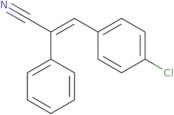
(2E)-3-(4-Chlorophenyl)-2-phenylacrylonitrile
CAS: 3695-92-9
Ref. 3D-FC131126
| 1g | To inquire | ||
| 2g | To inquire | ||
| 5g | To inquire | ||
| 10g | To inquire | ||
| 500mg | To inquire |
Product Information
- benzeneacetonitrile
- alpha-[(4-chlorophenyl)methylene]-
- (2E)-3-(4-chlorophenyl)-2-phenylprop-2-enenitrile
- (2Z)-3-(4-chlorophenyl)-2-phenylprop-2-enenitrile
- 3-(4-Chlorophenyl)-2-Phenylprop-2-Enenitrile
- 3-(p-Chlorophenyl)-2-phenylacrylonitrile
- 4-Chlor-benzal-(benzyl-cyanid)
- 4-Chlor-benzal-(benzyl-cyanid) [German]
- Acrylonitrile, 3-(p-chlorophenyl)-2-phenyl-
- Benzeneacetonitrile, alpha-((4-chlorophenyl)methylene)-
- See more synonyms
- Benzeneacetonitrile, α-[(4-chlorophenyl)methylene]-
- F 2388
- Nsc 214552
- α-[(4-Chlorophenyl)methylene]benzeneacetonitrile
2-Phenylacrylonitrile is an organic compound that is the nitrile derivative of an aldehyde. It can be synthesised by reacting acrylonitrile with sodium cyanide and then heating the mixture to produce the desired product. The synthesis of 2-phenylacrylonitrile starts with the reaction of acrylonitrile and sodium cyanide, which produces a nitrile group on one of the benzene rings. This product can then be heated to produce 2-phenylacrylonitrile. The electronic properties of this compound are similar to those found in other pyridine derivatives, as it has an electron withdrawing group (nitrile) attached to a pyridyl ring. One difference between 2-phenylacrylonitrile and other pyridine derivatives is that it contains an active methylene group, which means that it has more than one double bond in its molecule. The absorption spectrum for 2
Chemical properties
Technical inquiry about: 3D-FC131126 (2E)-3-(4-Chlorophenyl)-2-phenylacrylonitrile
If you want to request a quotation or place an order, please instead add the desired products to your cart and then request a quotation or order from the cart. It is faster, cheaper, and you will be able to benefit from the available discounts and other advantages.





